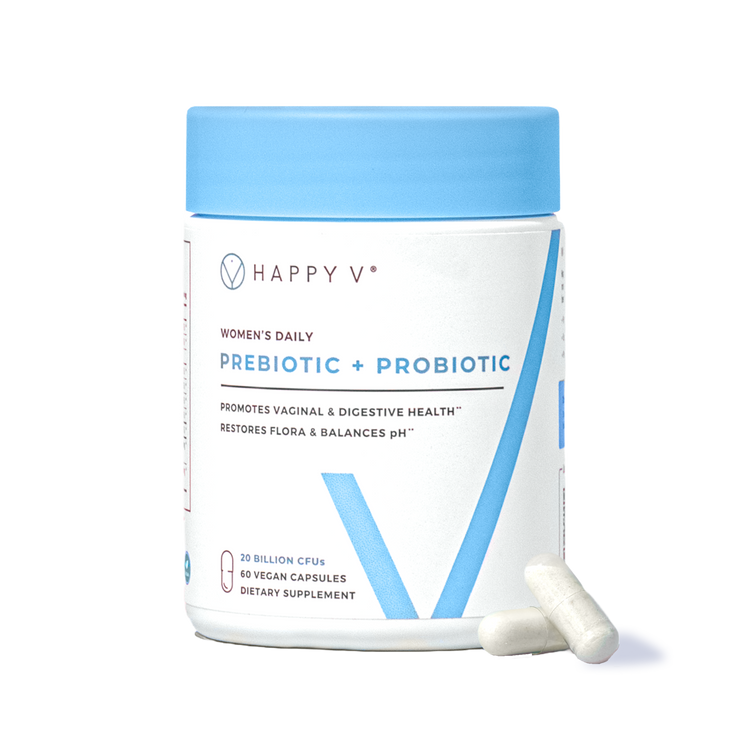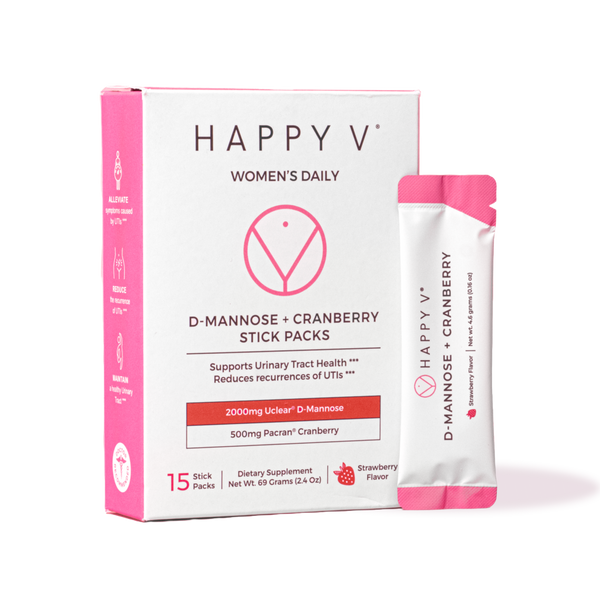- Fact Checked
- August 27, 2022
- 8 min read
Table of Contents
If you’ve ever had discomfort or strange vaginal discharge coming from your genitals, you may have wondered if your symptoms were due to a yeast infection, which is sometimes called thrush, or another type of infection. Unfortunately, although bacterial vaginosis (BV) is the most common vaginal infection, impacting over a third of all adult women during their lifetime, it’s often misdiagnosed by healthcare providers as thrush. (1) Without proper diagnosis and treatment, bacterial vaginosis infections can cause significant embarrassment, physical discomfort, and even health complications.
Although BV and vaginal yeast infections have some of the same common symptoms, they are very different infections with different causes and treatment. In this blog, we’ll help you learn to differentiate between these two common infections so you can get the proper medical care when something’s not quite right down there and quickly restore your vaginal health.
What Is Bacterial Vaginosis?
BV is a vaginal bacterial infection caused by the overgrowth of bacteria within the human vagina. BV the most common bacterial infection affecting pre-menopausal women (women between the ages of 15–44). Around 21.2 million women are affected by BV every year in the United States. (2)
Having vaginal bacteria is normal, but usually, the acidic vaginal pH keeps healthy bacteria and bad bacteria levels balanced. The primary good bacteria in the vagina are called vaginal lactobacilli. These good bacteria are responsible for the production of lactic acid and hydrogen peroxide within the vagina. Lactic acid keeps the vaginal environment mildly acidic, inhibiting the growth of bad bacteria such as Gardnerella vaginalis, Prevotella species, and other gram-negative anaerobic bacteria.
Lots of external factors can decrease your body’s lactobacilli bacterial balance, disturbing the normal pH level of your vagina. When your vaginal pH is disturbed, your vagina becomes less effective at maintaining a normal balance of bacteria, increasing your chances of developing BV.
Antibacterial treatment is needed to get rid of BV and restore your vaginal health. If you think you have BV, it’s important to get treatment, since untreated BV can cause other health problems, including Pelvic Inflammatory Disease, pregnancy complications in pregnant women, and an increase in risk of developing a sexually transmitted infection.
What Is Thrush?
Unlike BV, thrush is a fungal infection. It’s a very common infection—in fact, about 75% of women will develop vaginal thrush at some point. (3) Thrush is caused by excessive growth of a certain type of fungal yeast, called Candida, within the vagina (that’s why thrush is sometimes called vulvovaginal candidiasis!).
Candida is a common yeast usually present in the vagina in a very low concentration. However, certain conditions can cause it to grow excessively. This disruption in the body’s normal balance of Candida results in a vaginal yeast infection, or thrush. Prescription antifungal medication is usually prescribed to deal with thrush.
How To Tell the Difference Between BV and Thrush
There are three key factors to examine when differentiating between the vaginal symptoms of BV and thrush, but they all come down to abnormal discharge. If you think you have BV or thrush, pay attention to the color of your vaginal fluid, the odor of the discharge and the thickness of the discharge, since a proper assessment of symptoms can help you determine which infection you have.
- Discharge color—The color of your discharge can help you to determine what infection you’re experiencing. If you have thrush, your discharge is probably whitish in color. If you have a BV infection , then the color of the discharge will likely be yellow to greenish.
- Abnormal odor—The vaginal discharge produced as a result of a yeast infection typically doesn’t have an odor, but the discharge produced from BV has a distinctively strong fishy smell.
- Unusual texture—In the case of vaginal yeast infection, discharge is usually lumpy and thick, similar to cottage cheese. The discharge produced by a BV infection is usually thin and milky.
Common Causes of Bacterial Vaginosis and Thrush
The key to avoiding these two common vaginal infections is understanding the factors that cause them—in many cases (but not all!), BV and thrush are entirely preventable with the right precautions. These two infections occur so frequently because they are directly dependent on your lifestyle, your hygiene, and your sex life. (4)
If you want to avoid getting BV or thrush, do what you can to avoid these 9 common risk factors for vaginal infections.
Having Female Sexual Partners
While the link between sexual contact and BV isn’t fully understood, having female partners makes women more susceptible to contracting a vaginal infection than women with male sex partners. (5)

Practicing Unprotected Sex
A healthy vaginal pH is around 4.5. The pH of semen is between 7.1–8.0, so when you have unprotected sex, the pH of semen can disrupt your acidic vaginal environment and cause a vaginal infection.
Using Low-Quality Menstrual Products
In order for tampons and sanitary pads to be effective, they must be absorbent. However, this can cause a problem when you’re trying to avoid a vaginal infection, since these cotton-based products retain fluid that can disrupt the vaginal environment and provide an ideal environment for the growth of bad bacteria. Additionally, low-quality sanitary pads contain harsh chemicals which can cause a pH imbalance.
Sharing Sex Toys
A 2010 study investigated which factors caused women with female sex partners to have an increase in risk of developing BV. (6) This risk is correlated with the use of vaginal lubricant and shared vaginal sex toys.
Sharing is not caring when it comes to sex toys. Sex toys can carry bacteria if they are not washed properly after each use. Make sure to wash them after every single use and do not share your toys with anyone.
Douching Regularly
While many women consider douching necessary for good hygiene, douching is actually harmful to vaginal health. (7) That’s because when you clean the inside of your vagina by douching regularly, you wash away good bacteria as well as bad bacteria. With low levels of good bacteria, bad bacteria are able to grow in number and cause infections.
Eating a Poor Diet
Studies show that diets high in fat put people at risk of BV, while sugar and yeast infections are also linked. (8) Instead, try a well-balanced diet rich in vitamin A, calcium, and folate to lower your risk of infection. Adding a probiotic for vaginal health to your diet can also help replenish your body’s store of good bacteria, warding off infection.

Staying in Wet Clothing
Staying in wet or tight clothing after exercising or swimming can cause you to develop a vaginal infection. That’s because a wet, moist environment created by wet, tight-fitting clothing is the perfect environment for bad bacteria or fungus to grow and thrive.
Using Soaps or Chemicals in the Vagina
Feminine hygiene sprays, soaps, and vaginal creams contain a large number of strong bases, surfactants, and other chemical substances which might result in increased pH levels when used in the human vagina and ultimately lead to infection.
Overusing Antibiotics
While we’d never advise you to neglect taking antibiotic treatment when prescribed, overusing oral antibiotics can deplete your body’s natural balance of good bacteria and cause other health issues, like vaginal infections.
How Does a Healthcare Provider Diagnose BV?
The diagnosis of BV is based on 4 clinical criteria: (9)
- The presence of foul or fishy smell vaginal odor
- Unusually thin, white discharge
- Vaginal pH greater than 4.5
- The presence of clue cells (cells of the vaginal lining exhibiting adhering bacteria)
Treatment Options for BV
Although many women get BV every year, 84% of women with BV have no symptoms. (10) However, if you notice any abnormal discharge, pain, or fulfill any three of the above-mentioned diagnostic criteria, you should discuss a BV diagnosis with your health care provider. Even if your symptoms aren’t severe, you may be one of many asymptomatic women with BV.
If you’re diagnosed with BV, your health care provider will likely prescribe you metronidazole. Metronidazole is first-line bacterial vaginosis treatment. (11) It can either be taken twice daily for at least 7 days as an oral treatment, or it can be applied as a gel once daily for 5 days.
Over-the-counter products are also available for treatment of BV if you have had it before and are certain of your diagnosis. Medical-grade boric acid can be applied at a dosage of 600 milligrams once daily for 21 days. Cranberry pills for BV, elderberry extract, and probiotics can also help you control recurring BV.
How To Prevent BV or Thrush
Preventing any vaginal infection, including BV or thrush, comes from avoiding practices that could trigger these infections. To prevent BV or thrush:
- Avoid douching—remember, the vagina is designed to self clean!
- Don’t use vaginal sprays, soaps, or other chemical products on your genitals.
- Change out of wet clothes immediately after exercise or swimming.
- Change pads or tampons frequently, at least every 3–4 hours, while on your period.
- Wash your sex toys before every use, and don’t share them with anyone.
Whatever’s Going On Down There, Happy V Products Can Help
BV and thrush have many similar symptoms and causes, so it makes sense that they’re easily confused. If you have any abnormal vaginal infection, Happy V has natural products to help you move past infection and maintain your vaginal health.

Prebiotic + Probiotic
Maintains vaginal pH and restores gut health.











